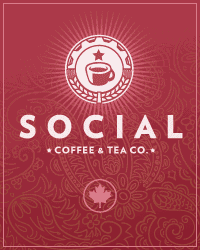… some professionals in the world of coffee think so.
These baskets are a new approach to espresso machine filtering, developed by Vince Fedele of VST (the company that produces the ExtractMojo and associated products).
A few years back, Fedele gave a lecture in Milan about espresso filter baskets and proposed a potential system for analysing and improving them. His discussion intrigued one company enough that they commissioned the building of the system. That company was La Marzocco, and with this partnership, VST was able to start the ball rolling. Filter baskets in espresso machines were given their first really serious and sober examination in some time, and efforts were started to try to find a way to make them better, but still design them to be usable in existing machines.
The results of these efforts produced three different basket sizes with a fourth one on the way. But it’s not just the physical size of these baskets that are different: the holes, their size and placement are given extreme attention for each individual basket size. The four sizes are: the 7 gram basket (still in development, not yet available); the 14 gram basket (VST will call this a 15g basket, as it can hold 14-16g); the 17 gram basket (VST ref 18g – can hold 17-19g); and the 21 gram basket (VST ref 22g, holding 21-23g).
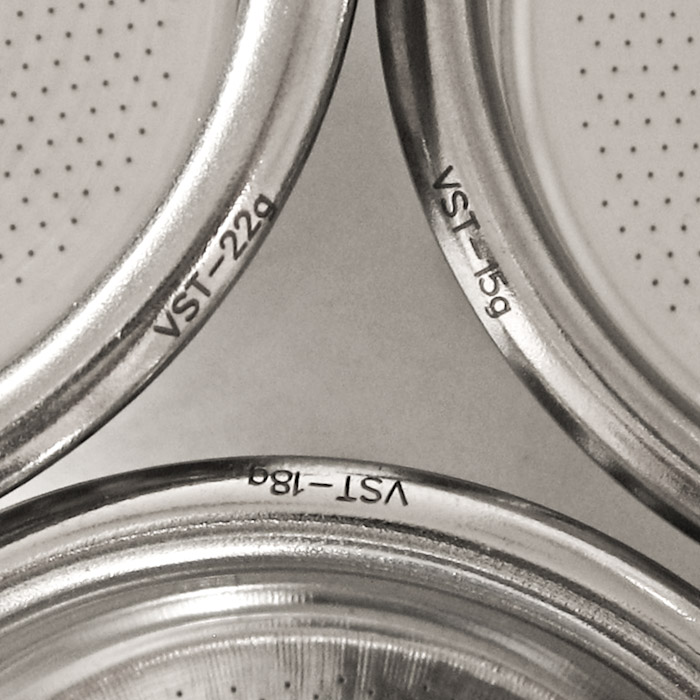
In this report I’ll try to provide as much detail as possible about these filter baskets. First, some history.
This process for testing and developing these filter baskets have been going on for several years now. Fedele sent early prototype baskets around the world to some of the top espresso professionals (and advanced enthusiasts) to give them a shakedown and enlist valuable feedback. La Marzocco pulled the baskets out at barista-oriented events earlier this year, and garnered many pro opinions on how they worked, how they could be improved, and how best to use them.
On Fedele’s side, he’s developed a completely new imaging and software system to help in the design, evaluation and production of these filters. Tests were done on countless versions of existing filter baskets (including many from sources either considered to have the best baskets, or claiming to have them) to evaluate their flaws and drawbacks. Shapes, materials, geometries, diameters, even the curves and tapers in a filter basket were exhaustively examined and evaluated to find out what worked, what didn’t, and what was broken.
The fruit of all this labour are four basket sizes with very specific coffee weights. When I say specific, I’m saying a 2 gram maximum swing specific. In the development of the baskets, one of the things learned was the value of around 1-2mm separation (depending on the type of coffee used, but leaning towards 2mm) from the top of the bed of coffee and the bottom of a dispersion screen. For many testers, this was deemed the optimum clearance to allow for full and complete saturation of the bed of coffee. The vertical depth of each basket is designed with this 2g max swing in weight while still hitting desired target extractions as shown with an ExtractMojo refractometer test and Mojo’s Brewing Control Chart.
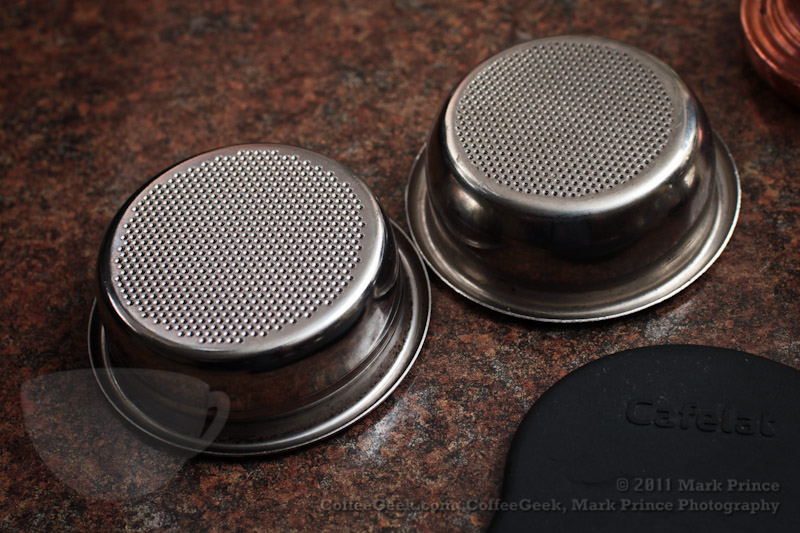
Water flow through the bed of coffee was also exhaustively examined, and what seems like common sense was in fact the case: water wants to flow straight down. Most current day baskets have a curve or taper in their lower portion; this means there’s less of the bottom platform (and less holes) for espresso to flow through, compared to the top of bed of coffee, where water first makes its impact.
In fact, some popular filter baskets have only about 60% area on the bottom for liquid to flow through, as compared to the diameter at the top of the puck. This situation causes some interesting things to happen in a filter basket: water as it flows through ground coffee and extracts will flow more quickly through some parts of the filter (the middle and an inner donut ring on the puck) and slower, and more stalled in other parts of the puck (the outer ring). That poorly saturated brew then swings back to the centre on the bottom of the puck, mixing with better saturated brew early on in the shot extraction. Later on, things get worse: the outer ring of coffee starts to extract more evenly, but the increased flow through the central parts mean over-extraction begins.
I could go on and on, but suffice to say: existing baskets, with a much smaller exit surface area vs a larger entry area on top for liquid often result in uneven, sometimes unpredictable extractions. The answer would be to maximize the bottom flat portion of the basket, with as many holes as possible to the edges. This is one thing the VST baskets do.
Getting a bit more miniscule, we focus next on the hole sizes. Hold up any current espresso filter basket to light. Really look at it. Almost every hole is a different size and shape. This is a problem — your flow through rates are increased at some areas, decreased at others. Some holes are so big that grind particles can easily pass through. Some are so small they can easily get plugged up by ground coffee, which further screws up extraction rates in isolated parts of the basket.
The VST baskets solve this through a patent-pending (and protected) manufacturing and testing process. Where most baskets have a wide spread of sizes for holes (sometimes as many as 200 different hole sizes in one filter), the VST baskets, by contrast, 3 to 5 hole size spread for almost every exit hole in the filter. They are just that uniform, and that leads to better, more even extraction possibilities.



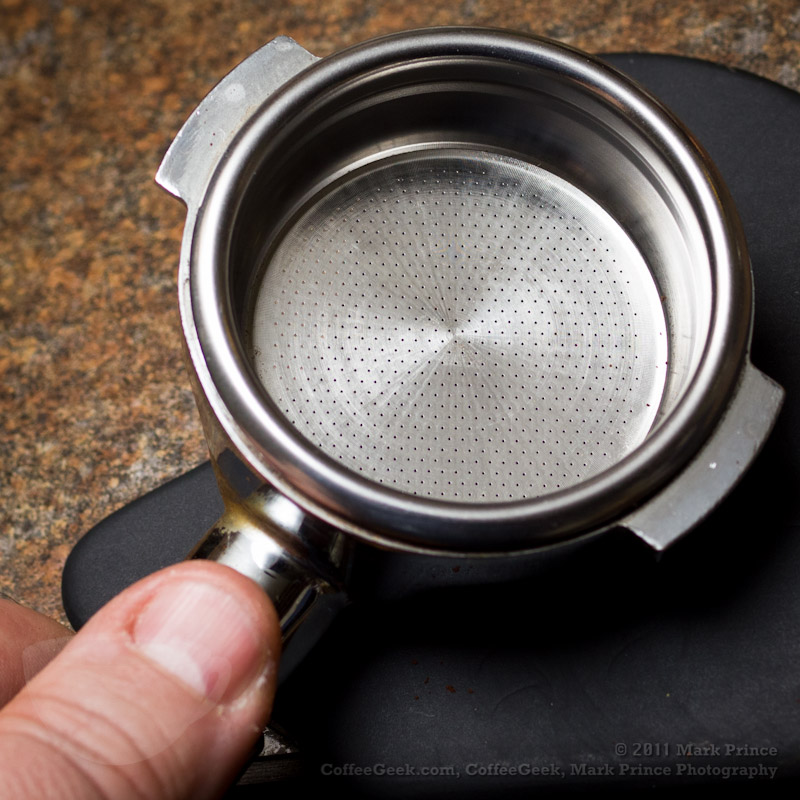
There can be a bit of a learning curve to these baskets. I found that out myself when Fedele sent me a triple basket last summer. I tried it maybe a half dozen times, saw some flaws in the pour, and gave up.
Last month I got a 17g basket. Again, saw some major flaws in my pours. I tweeted about it, and my good friend Andy Schecter wrote me the following:
Mark, I think your tweets about problems you’re having with the LM basket may embarrass you in the end. There are pro baristas with some pretty famous names and pretty substantial street cred who like the baskets a lot. I suggest that the problems you’re having may lie, as they say, “on the handle side of the portafilter.”
Andy Schecter
Of course, I didn’t much like getting this email, but it made me think: okay, I can’t be right (these baskets suck!) and so many pros be wrong. So I did look at my technique and also had a very long phone call with Fedele. Then I figured out the problem. It was me.
My tamping technique over the years evolved into something that (unconsciously) was helping overcome existing filter basket problems: namely the curved bottoms, the inconsistent hole sizes and more. I’d load up a filter basket with a central pyramid like cone, and avoid touching the coffee at all costs. I also would knock down the loading bed of coffee while grinding – one or two knocks at 1/3 full, another one or two knocks at 2/3 full. The result was a nice, even cone of coffee in the filter basket. This is why I liked the Anfim Super Caimano grinder so much: it can dose a nice even cone every time.
Then I’d take my own tamper (one I designed) which has a trick: it leaves lots of coffee out at the edges. I don’t want to get into too much detail about the tamper, but suffice to say, my dosing, leveling (ha!) and tamping technique left me with a bed of compressed coffee that had more density in the centre, and a lessening of that density as you go out to the outer edge.
This resulted in pretty good extractions from most modern day filter baskets (especially my previous favourite, the Synesso 14g basket). But, using the same technique delivered questionable extractions in the new VST / La Marzocco baskets. Knowing some of the science behind extractions (and especially after my discussion with Fedele), I figured it out: since there’s more straight-path flow in a VST basket, I was setting up an environment where the central part of my packs were not getting nearly as much water flow as the outer diameter was. Result: my extractions were poor, and showed many signs of a flawed extraction (bad ExtractMojo readings, pitting, fractures, jets, donut shaped pours from a chopped portafilter, etc etc).
Synesso / Kurv Tamper Technique
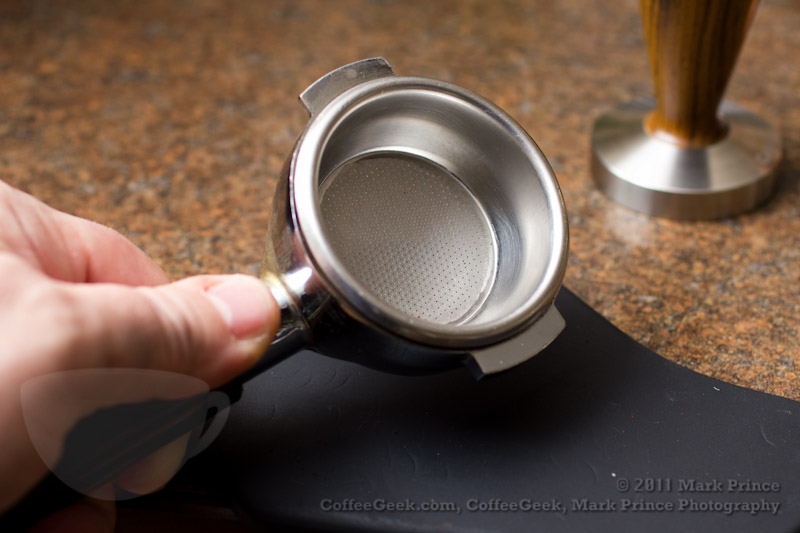

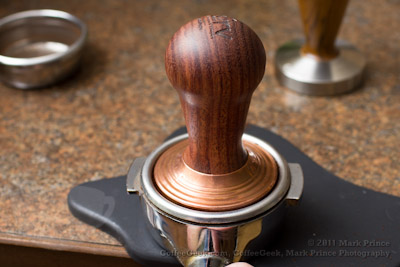

So I changed my dosing, leveling and tamping style. I did my knock downs of the bed of coffee only after fully dosing. I started using Scottie Calaghan’s dosing tools to sweep the baskets (I’ve settled on using the #14 sweep, which has a good curve). I brought my doses down to 17-18g (adjusting grind accordingly). I ended up with a non-compressed bed of coffee that had a nice central concave dip. I also switched to a flat bottomed tamper. No curves at all. The compressed coffee pack in the VST baskets were flat topped, but the density of the coffee was probably a smidge more on the outer rim than it was in the centre (hard to tell, since loading up on the grinder puts coffee centre in the basket: my sweep only really affects the top portion). It may be safe to say this dosing technique results in a very uniform density pack throughout the filter.
VST / La Marzocco Basket Flat Tamper Technique

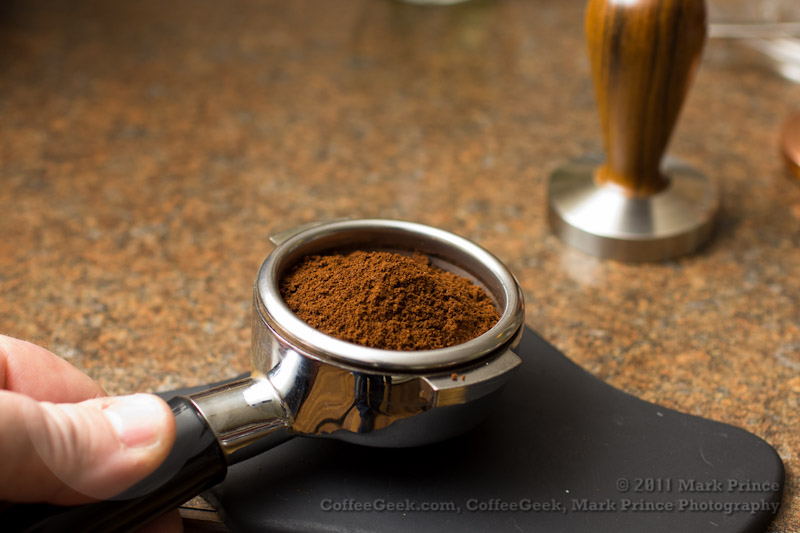

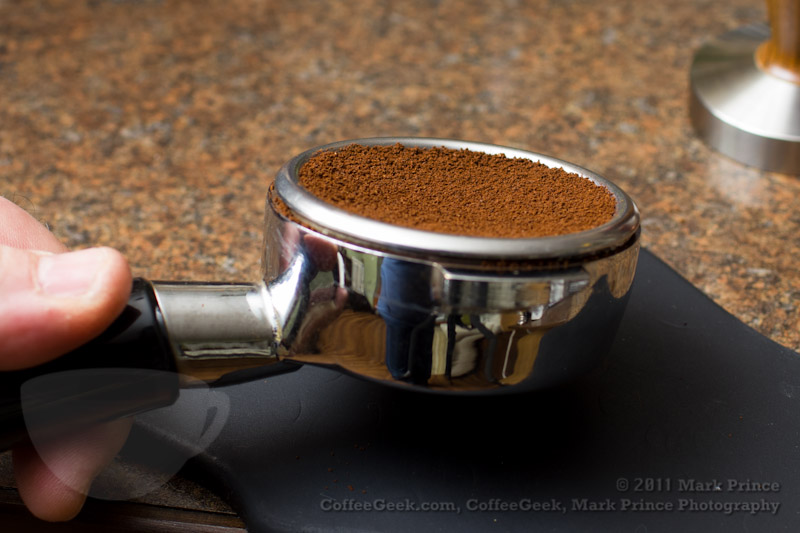
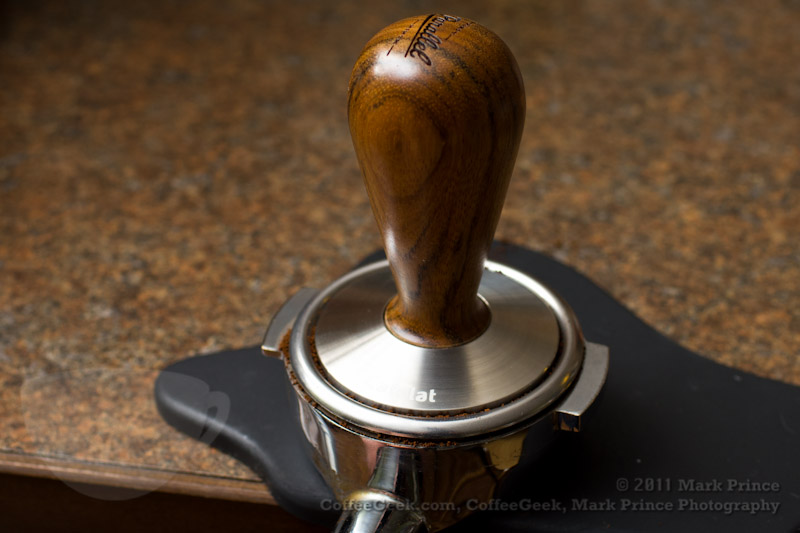
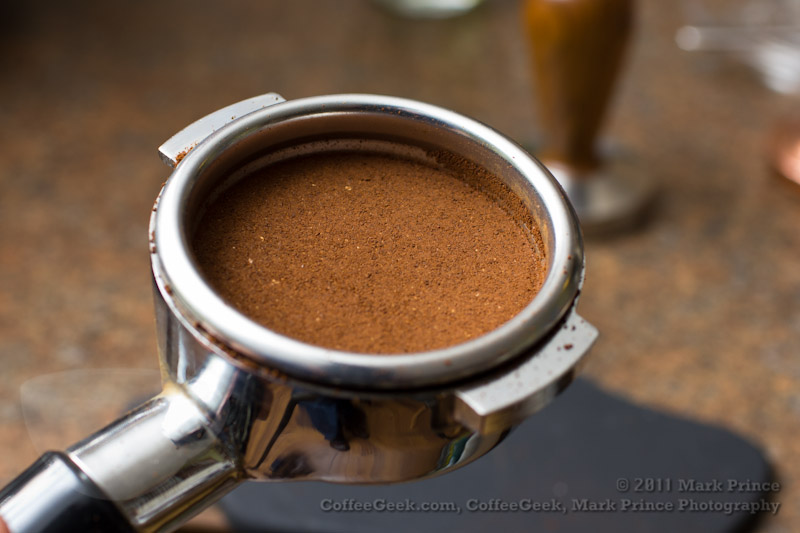
And the shots? On the Extract Mojo I started noticing something: I could use the same amount of coffee, same grind, same dose, level and tamp. I’d vary how long I pulled the shots – sometimes pulling 28g brew volume (ristretto); sometimes pulling 35-38g volume (normale as Fedele calls that) and sometimes pulling up to 45g (a luongo). All these shots were still within good extraction ratios Brewing Control Chart! But more importantly, all the shots maintained a decent amount of sweetness in the taste, throughout the size differences. For me, the normales tasted the best, but the luongo was definitely drinkable, and the ristretto even more so.
And the taste? In a word: improved. In two words: major improvement. In another two words: consistently improved.
We’ve done some blind taste tests here. We set up grind fineness, dosing weight and brew temperature as standard across all basket tests (other things are modified for each test shot). Pulled one double shot using my old dosing, leveling, (ha!) tamping technique on Synesso baskets. Aimed for 35g brew volume, found we had to stop it shorter (around 31g max) because that was where the taste was best.
Then, we pulled shots with the VST 17/18g basket, using the new dosing, leveling and tamping technique. Found that every single shot tasted better, but even more impressive, varying the shot output (going from 30 to 40g brewed) still resulted in shots that tasted better than our “best” Synesso basket shot.
This isn’t me claiming these taste results. This is three seasoned local baristas and two consumers over three testing sessions. It was a lock for the VST / La Marzocco baskets and a serious eye-opener on how important the filter basket is to the brewing process.
Available at SCAA Houston

You can find out much more about these baskets if you happen to be in Houston this weekend (April 29-May 2, 2011), because Fedale will be at the La Marzocco booth and La Marzocco will be demonstrating these baskets to all who drop by. If you’re a La Marzocco customer, you will of course be able to get these baskets directly from La Marzocco very soon (and they should be shipping with most of La Marzocco’s machines soon as well).
Even better yet, you can buy these baskets in three sizes (14/15g, 17/18g, 21/22g), as of today: VST will start selling these baskets (via pre-order) through their website. (The fourth size, the 7g, is still TBA).
And even better still, want these baskets like, immediately? If you’re attending the SCAA show, you can get them – at least the two largest sizes (17/18g and 211/22g). Buy the baskets on VST’s website (pre-order), and Fedele says he has a limited number for pickup if you do pre order them (he won’t be accepting payments at the show).
The baskets are $25 each. They are available in individual boxes or the 17/18g and 21/22g are packaged together. The prices are $25 per basket (the double set is $50). Those ordered through the website will be shipping very soon.
Can these baskets change espresso for the better? We’ll be getting many more opinions very soon as more and more seasoned espresso professionals get to try them out. But early on, and with all the testing done, I’d say they have the potential.



